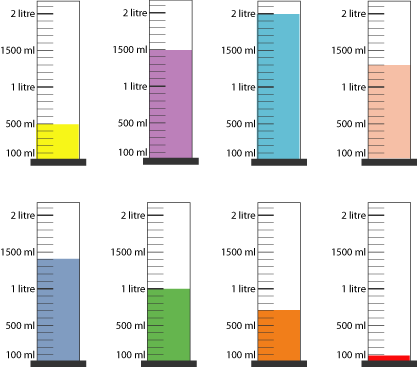Copyright © University of Cambridge. All rights reserved.
Oh! Harry
A group of eight children in Class 6 were measuring water using measuring cylinders. They coloured the water to make reading the scales easier.
They lined up the cylinders in two neat rows, each labelled with a child's name and the amount they had measured out.
Then Harry opened the window and the wind blew most of the labels onto the floor! "Oh! Harry!" they all wailed. Can you relabel the cylinders for them?

Ahmed had measured out just a thousand millilitres and Belinda twice as much as Ahmed.
Grace had measured out three-quarters of the amount that Belinda had done and Freddie had half the amount that Ahmed had measured out.
Which were their cylinders?
Callum had coloured his water blue. How much did he measure out?
Ellie had coloured her water pink and Dan coloured his orange. How much did they measure out?
"Don't drink that!" Harry had laughed, pointing at Dan's cylinder, "It's not orange juice!" As his hand stretched out he knocked over his red liquid. "Oh! Harry!" they all wailed again.
How much was left in Harry's cylinder after the accident?
You can download a
resource sheet of the measuring cylinders.
Why do this problem?
This problem is a way of practising reading scales in a challenging context. The challenge comes from the reasoning involved.
Possible approach
This activity could form part of a lesson on reading scales or one on capacity.
You could have the image of the cylinders on the board as an introduction, and begin by reading the clues together. (You may find
this SMART notebook file useful. It contains the images from the problem, and the text which can be revealed gradually. Thank you to Mark Dawes for allowing us to share this file.) Ask learners to think on their own
about which clue they could use first, then encourage them to talk to a partner. Invite suggestions from the whole group about where to start and why. Children could then work in pairs on the problem.
As the children work, listen to their discussions and in particular listen out for those who are justifying their choices clearly. Warn a few of these pairs that you would like to hear from them during the plenary, asking them to focus on their reasoning and explanations.
Key questions
Which cylinder do you think holds 1000 ml?
Which would be another easy one to try?
Which clue could we use next?
Possible extension
Children could write their own questions using the
blank sheet.
Possible support
Children could use the
resource sheet and write down the amount in each cylinder. Alternatively,
this sheet with the clues and space for noting the amount in each cylinder, might be useful. It might help to have labels of the children's names, for example on pieces of
paper or card, which can be moved around underneath each measuring cylinder.
